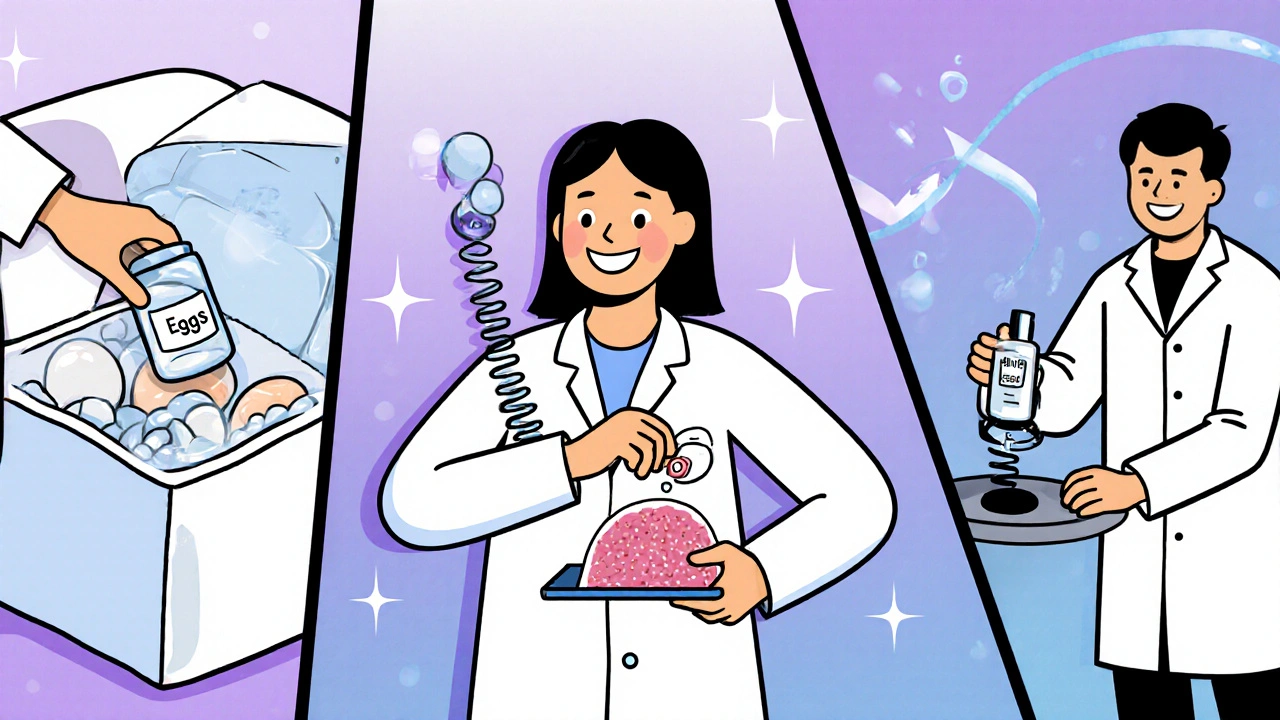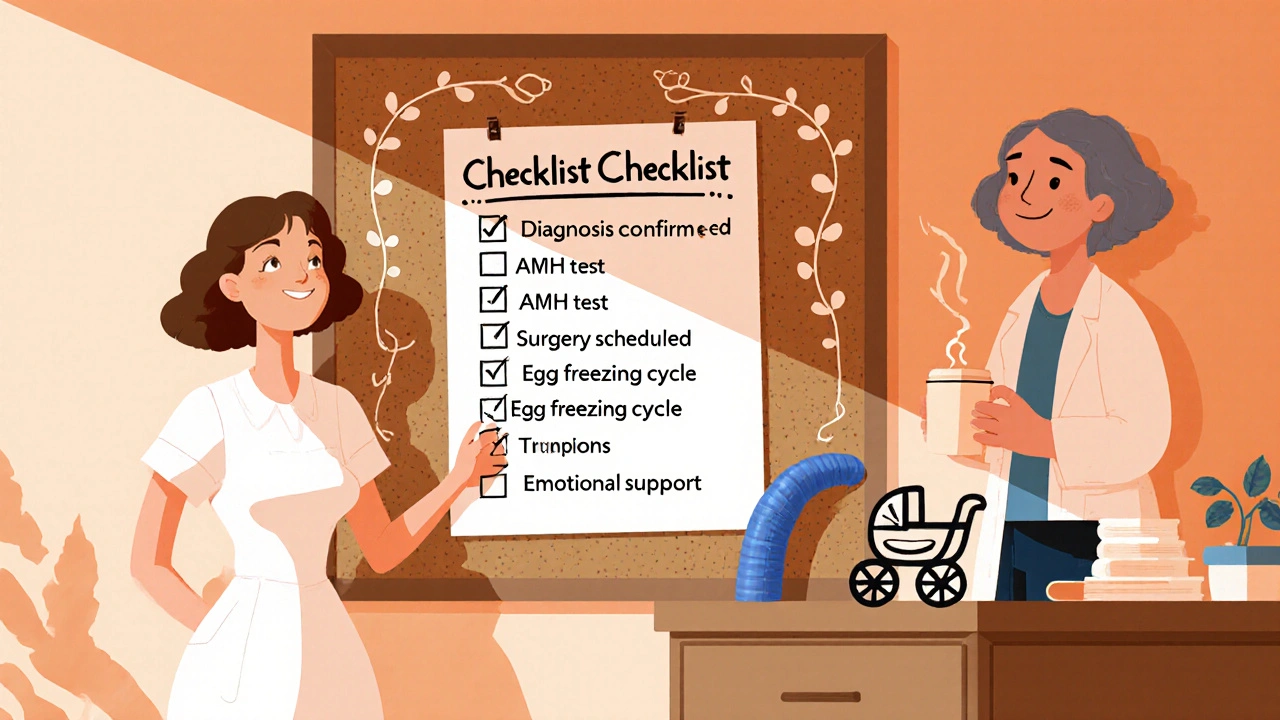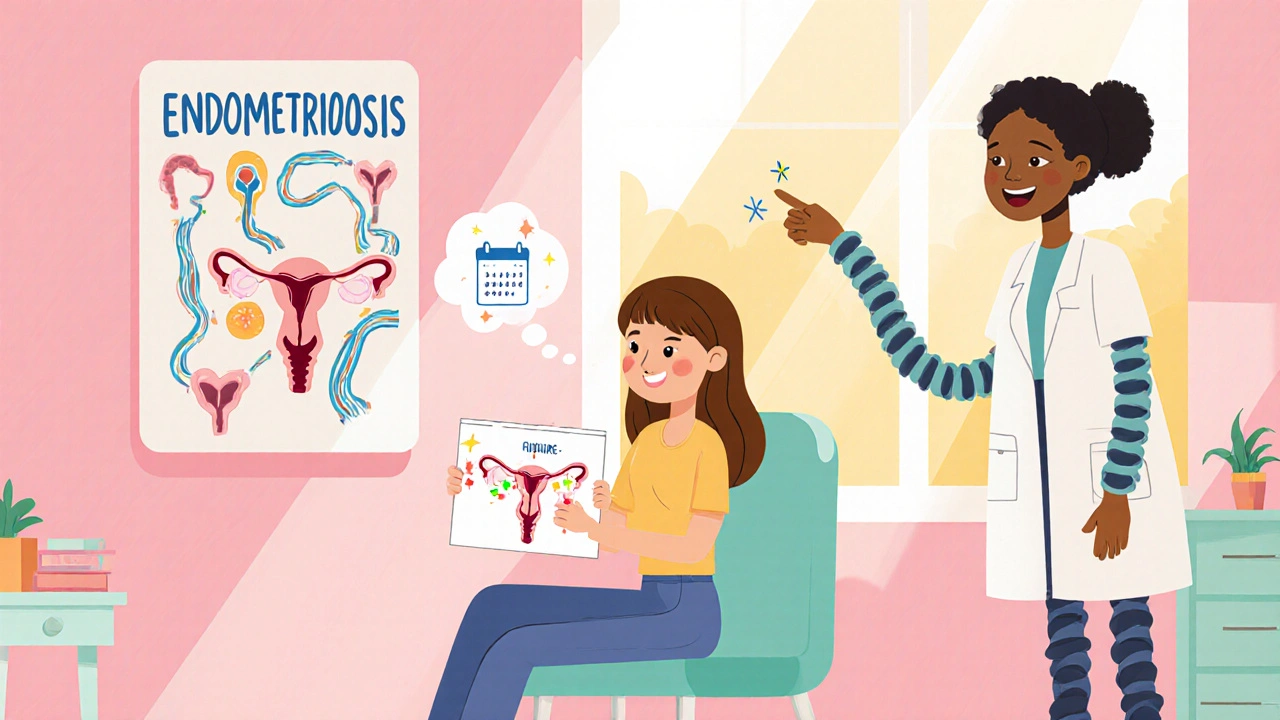Fertility Preservation Decision Guide
Our tool analyzes your inputs to provide recommendations based on:
- Age and ovarian reserve
- Relationship status and need for sperm
- Endometriosis stage and potential impact on ovarian function
- Success rates for different preservation methods
Remember that this is a guide only, not medical advice. Always consult with your reproductive endocrinologist.
Key Takeaways
- Endometriosis can lower ovarian reserve and impede implantation, but many women still achieve pregnancy with the right plan.
- Fertility preservation methods include egg freezing, embryo freezing, and ovarian tissue freezing; each has specific pros and cons.
- Early consultation with a reproductive endocrinologist helps you map your ovarian reserve, disease stage, and timeline.
- Surgical removal of endometriotic lesions can improve fertility, but timing the surgery around preservation cycles matters.
- Creating a personalized checklist-medical, financial, emotional-keeps the process clear and reduces stress.
What Is Endometriosis?
Endometriosis is a chronic, estrogen‑dependent condition where tissue similar to the uterine lining grows outside the uterus. Common sites include the ovaries, pelvic peritoneum, and uterine ligaments. This ectopic tissue bleeds each month, causing inflammation, scarring, and adhesions that can distort pelvic anatomy. About 10% of reproductive‑age women worldwide live with it, and the average diagnostic delay remains roughly 7‑10years. Symptoms range from painful periods and chronic pelvic pain to painful intercourse and, for many, reduced fertility.
How Endometriosis Impacts Fertility
Three main mechanisms link endometriosis to lower pregnancy rates:
- Ovarian reserve depletion: Endometriomas (ovarian cysts) can damage healthy follicles and reduce Anti‑Müllerian Hormone (AMH) levels.
- Distorted anatomy: Scar tissue can block the fallopian tubes or hinder the egg‑sperm meeting point.
- Inflammatory environment: Elevated cytokines and prostaglandins may affect embryo implantation and quality.
Because the impact varies by disease stage (I-IV), age, and individual ovarian reserve, a personalized assessment is critical before deciding on preservation.
What Is Fertility Preservation?
Fertility preservation refers to medical techniques that safeguard a woman’s reproductive potential for future use. Options include cryopreservation of oocytes (eggs), embryos, or ovarian tissue, as well as surgical strategies that protect ovarian function. It has become a standard offering in reproductive medicine, especially for patients facing cancer treatment, early‑onset menopause, or chronic conditions like endometriosis.
Primary Preservation Options
Below is a quick snapshot of the three most common methods. The table uses structured data so search engines can pull the comparison cleanly.
| Method | Ideal Candidates | Success Rate (live birth per thaw) | Key Pros | Key Cons |
|---|---|---|---|---|
| Egg Freezing (Oocyte Cryopreservation) | Women without a partner, ages 20‑38, early-stage endometriosis | ≈55‑65% (if eggs frozen before age 35) | Preserves autonomy, no need for sperm at freezing time | Requires hormonal stimulation; lower success if done after 38 |
| Embryo Freezing (Embryo Cryopreservation) | Women with a stable partner or donor sperm, ages 20‑38 | ≈65‑75% | Higher success than egg freezing, established technique | Legal/ethical considerations about embryo ownership |
| Ovarian Tissue Cryopreservation | Women <35years or those who cannot undergo stimulation | ≈30‑40% (still evolving) | Can be done without hormonal cycles; preserves follicles directly | Requires surgery; limited long‑term data in endometriosis |

Egg Freezing (Oocyte Cryopreservation)
This is the most popular option for endometriosis patients who want to keep their options open. The process involves:
- Baseline ovarian reserve testing (AMH, antral follicle count).
- Controlled ovarian stimulation (COS) using injectable hormones to recruit multiple follicles.
- Egg retrieval under mild sedation, usually 36hours after the trigger shot.
- Vitrification-rapid freezing that prevents ice crystal formation.
Because endometriomas can lower the number of recruitable eggs, many specialists recommend initiating COS as soon as the disease is staged and, if feasible, after a laparoscopic cystectomy. Studies from 2023‑2024 show that women who had their endometrioma removed before freezing achieved a 12‑15% higher average egg yield.
Embryo Freezing (Embryo Cryopreservation)
If a partner or donor sperm is already available, fertilizing the retrieved eggs creates embryos that can be frozen. Embryos have slightly higher survival after thawing because the embryo’s cellular structure is more robust. The steps mirror egg freezing, with the addition of intracytoplasmic sperm injection (ICSI) in the lab.
Legal considerations vary by country; in Australia, embryos must be stored in a licensed fertility clinic and can be kept for up to 55years, but the couple must consent to any disposition.
Ovarian Tissue Cryopreservation
This technique involves laparoscopically removing a thin slice of ovarian cortex, slicing it into strips, and freezing them. When the woman is ready to try for pregnancy, the tissue can be re‑implanted, often restoring natural ovulation.
It’s especially useful for women with severe ovarian adhesions where stimulation is risky. Recent Australian data (2022‑2025) indicate a 30% live‑birth rate after re‑implantation, and the method is gaining traction as a “safety net” for early‑stage disease.
Surgical Options to Boost Fertility
While cryopreservation safeguards eggs, many patients also benefit from surgery that removes lesions and restores anatomy. The most common procedures are:
- Laparoscopic Excision: Precise removal of endometriotic implants and cysts, preserving healthy ovarian tissue.
- Ablation (laser or plasma energy): Burns away superficial lesions; less tissue removal but may leave microscopic disease.
- Adhesiolysis: Cuts adhesions that block fallopian tubes or distort the uterine cavity.
Timing matters. If you plan to freeze eggs, surgeons often schedule the operation 2‑3months before COS to let the ovary recover.

Hormonal and Medical Strategies
Beyond surgery, medication can help manage disease activity while preserving fertility:
- GnRH Agonists (e.g., leuprolide): Induce a hypo‑estrogenic state, shrinking lesions before surgery.
- Oral Contraceptives: Provide pain relief but should be stopped before any stimulation cycle.
- Aromatase Inhibitors (letrozole): Used off‑label to improve ovulation in mild endometriosis.
These drugs do not replace preservation but can create a more favorable environment for egg retrieval.
Decision‑Making Checklist
Use this practical list during your next appointment:
- Confirm Diagnosis & Stage: MRI or laparoscopy report.
- Assess Ovarian Reserve: AMH, FSH, antral follicle count.
- Set a Timeline: Desired age for pregnancy vs. disease progression.
- Choose Preservation Method: Egg vs. embryo vs. tissue based on partner status, age, and surgical feasibility.
- Discuss Costs & Insurance: In Australia, Medicare may cover a portion of surgery; private health funds often cover storage fees.
- Plan Surgery & Stimulation: Coordinate dates to minimize ovarian stress.
- Prepare Emotionally: Seek counseling or support groups (e.g., Endometriosis Australia).
Checklist items can be ticked off in a printable worksheet-some clinics even provide digital versions.
Common Pitfalls & How to Avoid Them
- Waiting Too Long: Egg quality declines sharply after 35. Early referral improves options.
- Skipping Baseline Testing: Without AMH, you may over‑ or under‑estimate the number of cycles needed.
- Choosing a Single Method: Combining surgery with egg freezing covers both immediate and long‑term goals.
- Ignoring Legal Aspects: Clarify embryo consent forms early to avoid future disputes.
- Neglecting Follow‑Up: After freezing, schedule annual reviews of storage fees and health status.
Frequently Asked Questions
Can I freeze eggs if I still have endometriomas?
Yes, but many specialists recommend removing the cyst first. Surgery can increase the number of mature eggs retrieved and reduce the risk of ovarian damage during stimulation.
How many eggs should I aim to freeze?
Statistical models suggest 15‑20 high‑quality eggs give a ~70% chance of a live birth for women under 35. For ages 35‑38, aim for 20‑25 eggs to offset age‑related decline.
Is ovarian tissue freezing safe for women with endometriosis?
It’s considered safe, but the procedure requires laparoscopic removal of tissue, which can be technically challenging if adhesions are extensive. Success rates are lower than egg freezing, but it offers an option when hormonal stimulation is contraindicated.
Will my insurance cover fertility preservation?
In Australia, private health insurers may cover part of the cost if a medical justification (e.g., endometriosis with reduced ovarian reserve) is provided. Medicare covers the surgical removal of endometriomas but not the cryopreservation itself.
Can I use frozen eggs after a future IVF cycle?
Absolutely. Frozen eggs are thawed, fertilized with sperm (partner’s or donor), and transferred as embryos in a standard IVF cycle. Success rates depend on the age at freezing and the number of eggs available.
Endometriosis doesn’t have to be a dead‑end for motherhood. By combining early surgical intervention, thorough ovarian reserve testing, and the right preservation method, you can keep your options open and increase the odds of a healthy pregnancy when the time feels right.


Post A Comment